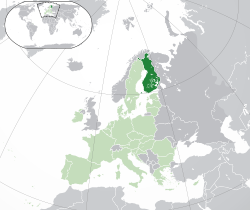Фіньско
Вызир
| Фіньска републіка | ||||||
|---|---|---|---|---|---|---|
|
||||||
| Гімна: |
||||||
 |
||||||
| Головне місто | Гелсінкы 60°10′N 024°56′E / 60.167°N 24.933°E | |||||
| Найвекшы міста | Головне місто | |||||
| Урядный язык | фіньскый, шведскый | |||||
| Влада | Парламентьска републіка[1] | |||||
| - | Презідент | Саўлі Нійнісцё 2012- | ||||
| - | Премєр-міністер | Юха Сіпіля 5/2015- | ||||
| Independence | ||||||
| - | Autonomy from Sweden |
March 29, 1809 | ||||
| - | Declared from Bolshevik Russia |
December 6, 1917 | ||||
| - | Recognised | January 4, 1918 | ||||
| EU accession | January 1, 1995 | |||||
| Теріторія | ||||||
| - | вєдно | 338,424 км2 (64th) 130,596 sq mi |
||||
| - | вода (%) | 10 | ||||
| Популація | ||||||
| - | шацованя 2010 | 5,374,781 (112th) | ||||
| - | списованя 2000 | 5,180,000 | ||||
| - | густота | 16/км2 (201st) 40/sq mi |
||||
| ГДП | шацованя 2010 | |||||
| - | вєдно | $183.095 billion[2] | ||||
| - | на жытеля | $34,044[2] | ||||
| ГДП (номіналный) | шацованя 2010 | |||||
| - | вєдно | $240.139 billion[2] | ||||
| - | на жытеля | $44,650.[2] | ||||
| Gini (2000) | 26.9 (low) | |||||
| ІЛР (2010) | ▲ 0.871[3] (very high) (16th) | |||||
| Валута | Євро (€)¹ (EUR) |
|||||
| Часова зона | EET (UTC+2) | |||||
| - | лїтнїй час | EEST (UTC+3) | ||||
| Date formats | d.m.yyyy | |||||
| Сторона движения | right | |||||
| Інтернет-домен | .fi[en], .ax[en] ² | |||||
| Телефонный код | 358 | |||||
| 1 | Before 2002: Finnish markka | |||||
| 2 | The .eu domain is also used, as it is shared with other European Union member states. | |||||
Фíньско (фін. Suomi, швед. Finland) — країна в Европі, член Европской Унії і НАТО.
Фіньско є членом Европской унії од року 1995, і членом НАТО од року 2023. B Фiньску є офіціална мена Евро. Густота залюднїня — 16/км².
Референції
[едітовати | едітовати жрідло]- ↑ В минулости полупрезидентска република, а теперь парламентска, але подля Давида Артера, першого ведучого катедры политологии Абердинской универзиты, котрый во своёй монографии "Scandinavian Politics Today" (Manchester University Press, revised 2008), цитує Яакко Нусиайнена зоз статї "From semi-presidentialism to parliamentary government" в Scandinavian Political Studies 24 (2), p95-109 такыма словами: "Не є найменшого оправданя про епитет 'полупрезидентска'." Властне Артерово заключіня лем кус тонше вывинуте: "З принятём новой уставы 1. марца 2000 Фіньско перестало мати полупрезидентске зряджіня, хыба в том найменшом вызнамі, же екзистує всенародно выбраный президент зоз фиксованов каденциёв попри премьєрови и кабинетови, котры суть зодповідны перед парламентом (Elgie 2004: 317)". Подля фіньской уставы, президент не мать можность росказовати владі без премьєрового сугласу, ани фактично не годен роспустити парламент по своёй воли. Фіньско теперь представлять премьєр, а не президент в Раді голов штатів и владї Европской Унії.
- ↑ 2,0 2,1 2,2 2,3 Finland. International Monetary Fund. http://www.imf.org/external/pubs/ft/weo/2010/01/weodata/weorept.aspx?sy=2007&ey=2010&scsm=1&ssd=1&sort=country&ds=.&br=1&c=172&s=NGDPD%2CNGDPDPC%2CPPPGDP%2CPPPPC%2CLP&grp=0&a=&pr.x=28&pr.y=11. [перевірено 2010-04-21].
- ↑ Human Development Report 2010. United Nations. 2010. http://hdr.undp.org/en/media/HDR_2010_EN_Table1.pdf. [перевірено 5 November 2010]. and Human Development Index trends, 1980–2010. United Nations. 2010. http://hdr.undp.org/en/media/HDR_2010_EN_Table2.pdf. [перевірено 7 November 2010].
| ||||||||
| |||||||
| |||||||
![]() Тота статя є затля „Стыржень“. Поможте Вікіпедії так, же єй доповните і росшырите.
Тота статя є затля „Стыржень“. Поможте Вікіпедії так, же єй доповните і росшырите.



